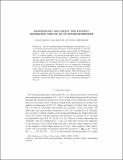Determining solubility for finitely generated groups of PL homeomorphisms
Abstract
The set of finitely generated subgroups of the group PL+(I) of orientation-preserving piecewise-linear homeomorphisms of the unitinterval includes many important groups, most notably R. Thompson’s group F. Here, we show that every finitely generated subgroup G < PL+(I) is either soluble, or contains an embedded copy of the finitely generated, non-soluble Brin-Navas group B, affirming a conjecture of the first author from 2009. In the case that G is soluble, we show the derived length of G is bounded above by the number of breakpoints of any finite set of generators. We specify a set of ‘computable’ subgroups of PL+(I) (which includes R. Thompson’s group F) and give an algorithm which determines whether or not a given finite subset X of such a computable group generates a soluble group. When the group is soluble, the algorithm also determines the derived length of ⟨X⟩. Finally,we give a solution of the membership problem for a particular familyof finitely generated soluble subgroups of any computable subgroup of PL+(I).
Citation
Bleak , C , Brough , T & Hermiller , S 2021 , ' Determining solubility for finitely generated groups of PL homeomorphisms ' , Transactions of the American Mathematical Society , vol. 374 , no. 10 , pp. 6815-6837 . https://doi.org/10.1090/tran/8421
Publication
Transactions of the American Mathematical Society
Status
Peer reviewed
ISSN
0002-9947Type
Journal article
Description
Funding: The first and second authors were partially supported by EPSRC grant EP/H011978/1. The third author was partially supported by grants from the Simons Foundation (#245625) and the National Science Foundation (DMS-1313559)Collections
Items in the St Andrews Research Repository are protected by copyright, with all rights reserved, unless otherwise indicated.

